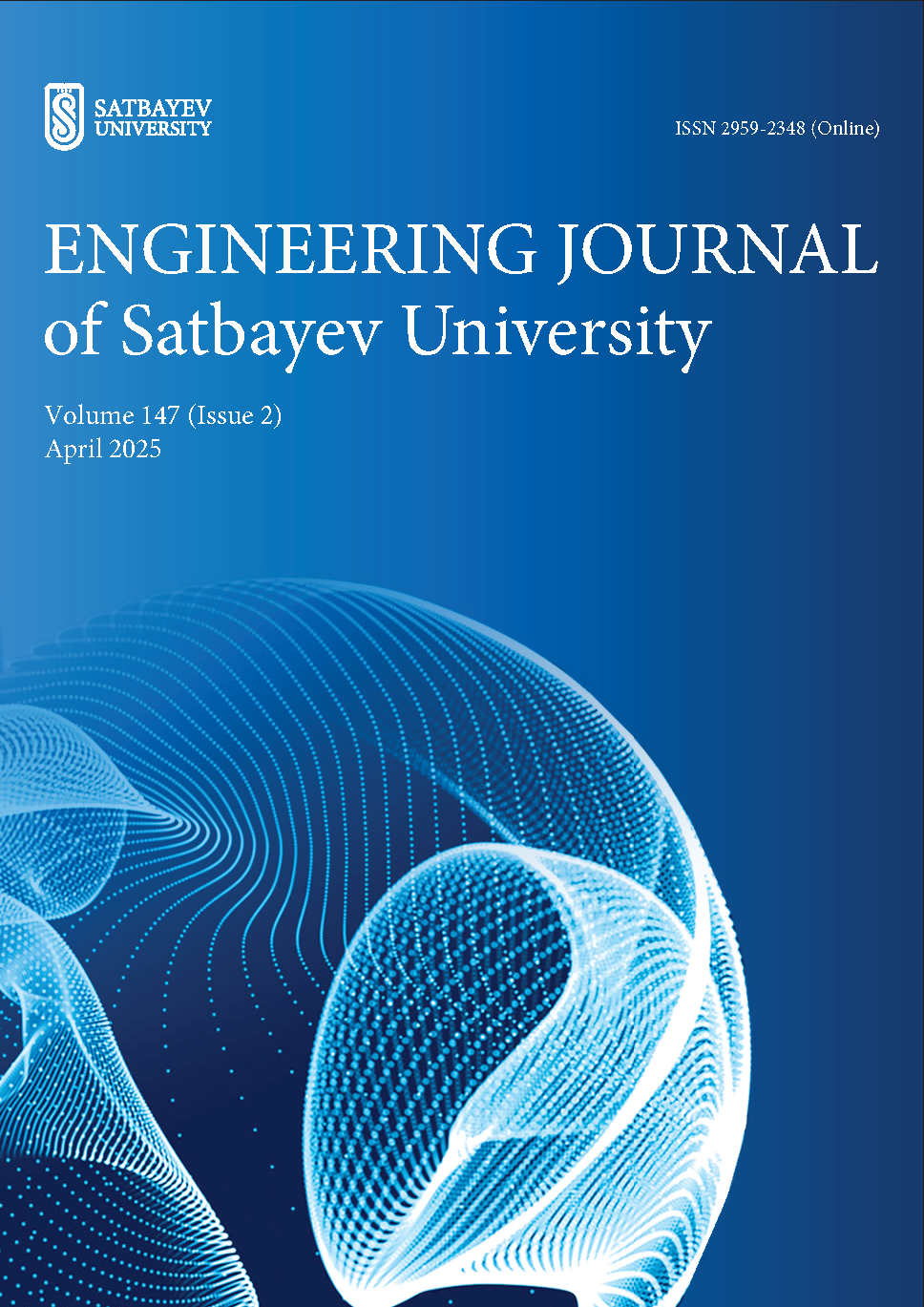Comparative analysis of the state of desertification of the lands of West and East Kazakhstan
DOI:
https://doi.org/10.51301/ejsu.2025.i2.06Keywords:
desertification, climate, temperature, humidity, precipitation, remote sensing, monitoringAbstract
The study performs an analysis and comparison of two completely different, but in some cases similar regions of West and East Kazakhstan. The influence of climate data changes, soil structure and its sensitivity on desertification in Kazakhstan over the decades of the 2000s, 2010s and from 2020 to 2024 is described using the example of West and East Kazakhstan. The author compared and detected that the soil types: Zg, XI, So, WR and KI are found both in the West and in the East of Kazakhstan exposed to degradation of soil structure. Climatic parameters, such as the temperature of the area fixed range between 3.6-4.9°С, humidity change significantly, all the time within 64% and 77%, and precipitation in different time periods changed from 416 mm to 605 mm. Using remote sensing data, the author analyzed changes in the natural environment, created visualizations and 3D modeling during the monitoring process. Thus, a set of existing research papers, statistical information and own experience were presented, since in the course of the work the results of scientific research on desertification were presented. The results of the study showed that there is an accelerated process of land desertification in Kazakhstan.
References
Jiang, L., Bao, A., Jiapaer, G., Guo, H., Zheng, G., Gafforov, K., Kurban, A. & De Maeyer, P. (2019). Monitoring land sensi-tivity to desertification in Central Asia: Convergence or diver-gence. Science of the Total Environment, (658), 669-683. https://doi.org/10.1016/j.scitotenv.2018.12.152
Shao, H., Liu, M., Shao, Q., Sun, X., Wu, J., Xiang, Z. & Yang, W. (2014). Research on eco-environmental vulnerability evaluation of the anning River Basin in the upper reaches of the Yangtze river. Environmental Earth Sciences, 72(5), 1555-1568. https://doi.org/10.1007/s12665-014-3060-9
Government website. (2024). About Kazakhstan. Administrative and territorial structure. Retrieved from: https://www.gov.kz/article/19305?lang=en
Assanova, M.A. (2015). Public policy and model of sustainable development in the re-public of Kazakhstan. Asian Social Sci-ence, 11(6), 237-243. https://doi.org/10.5539/ass.v11n6p237
Saigal Kazakhstan. (2015). Issues and approaches to Combat Desertification 2005-2015. Retrieved from: https://www.unccd.int/sites/default/files/naps/kazakstan-eng2005.pdf
Baitulin, I.O. (2001). National Strategy and Action Plan to Combat Desertification in Kazakhstan, Sustainable Land Use in Deserts. Springer, Berlin, Heidelberg. https://doi.org/10.1007/978-3-642-59560-8_47
Symeonakis, E., Karathanasis, N., Koukoulas, S. & Panagopou-los, G. (2016). Monitoring sensitivity to land degradation and desertification with the environmentally sensitive area index: the case of Lesvos Island. Island Degrad. Dev., 27(6), 1562-1573. https://doi.org/10.1002/ldr.2285
Veron, S.R., Paruelo, J.M. & Oesterheld, M. (2006). Assessing desertification. Journal of Arid Environments, 66(4), 751-763. https://doi.org/10.1016/j.jaridenv.2006.01.021
Liu, J., Wang, Y., Peng, J., Braimoh, A.K. & Yin, H. (2013). Assessing vulnerability to drought based on exposure, sensitivi-ty and adaptive capacity: a case study in middle Inner Mongolia of China. Chinese Geographical Science, 23 (1), 13-25. https://doi.org/10.1007/s11769-012-0583-4
Popov, M.G. (2011). Vegetation of Kazakhstan. Part 2. Re-trieved from: https://otherreferats.allbest.ru/geography/00008737_0.html
Amirkhanov, M.E. & Zhakypbek, Y. (2023). Remote sensing monitoring of desertification in the Kurchum district of east Ka-zakhstan region. International journal Young Scientist, 1.1 (448.1), 13–17
Saparov, A.S. (2013). Soil Research in Kazakhstan. Annual report. Retrieved from: https://www.fao.org/fileadmin/user_
upload/GSP/docs/eurasian_workshop/Soils_of_Russiaba.pdf
Zhumabayev, E.E. (2015). Strategic measures to combat deserti-fication in the Republic of Kazakhstan until 2025. Retrieved from: https://ecogosfond.kz/wp-content/uploads/2018/06/opus
tinivanie.pdf
Mamyrkhanova, M. (2022). How the East Kazakhstan region will be divided. Retrieved from: https://ru.sputnik.kz/20240117/rf-i-kazakhstan-dogovorilis-ob-uvelichenii-obema-tranzita-nefti-v-knr-do-10-mln-tonn-v-god-41642222.html
Oskemen Annual Weather Averages. (2017). Monthly Average High and Low Temperature. Average Precipitation and Rainfall days. Retrieved from: https://www.worldweatheronline.com/
Oskemen-weather-averages/East-Kazakhstan/KZ.aspx
Government website. (2024). Committee for construction and housing and communal services of the Ministry of investment and development of the Republic of Kazakhstan. Construction climatology of the Republic of Kazakhstan. Retrieved from: https://www.gov.kz/memleket/entities/kds?lang=en
Robinove, C.J., Chavez, P.S., Gehring, D. & Holmgren, R. (2021). Arid land monitoring using Landsat albedo difference images. Remote Sensing of Environment, (11), 133-156. https://doi.org/10.1016/0034-4257(81)90014-6
Sun, Q.Q., Zhang, P. Sun, D.F. Liu, A.X. & Dai, J.W. (2018). Desert vegetation-habitat complexes mapping using Gaofen-1 WFV (wide field of view) time series images in Minqin County. China. International Journal of Applied Earth Observation and Geoinformation, (73), 522–534. https://doi.org/10.1016/j.jag.2018.07.021
Amirkhanov, M., Zhakypbek, Y., Aben, A. & Mussakhan, N. (2023). Monitoring of glaciation and melting in the east Kazakhstan region. Almaty. Mining journal of Kazakhstan, (11), 27-30.
Ehleringer, J.R. (2021). Leaf absorptances of Mohave and Son-oran Desert plants. Oecologia, (49), 366-370. https://doi.org/10.1007/BF00347600
Republican State Enterprise Kazhydromet. (2023). An overview of the climate features in Kazakhstan. Retrieved from: https://www.kazhydromet.kz/uploads/calendar/192/year_file/6646ff553af2710-05-2024_obzor-osobennostey-klimata_kazahstan-za-2023.pdf
Downloads
Published
How to Cite
Issue
Section
License
Copyright (c) 2025 Engineering Journal of Satbayev University

This work is licensed under a Creative Commons Attribution-NonCommercial-NoDerivatives 4.0 International License.
<div class="pkpfooter-son">
<a rel="license" href="http://creativecommons.org/licenses/by-nc/4.0/"><img alt="Creative Commons License" style="border-width:0" src="https://i.creativecommons.org/l/by-nc/4.0/80x15.png"></a><br>This work is licensed under a <a rel="license" href="http://creativecommons.org/licenses/by-nc/4.0/">Creative Commons Attribution-NonCommercial 4.0 International License</a>.
</div>





